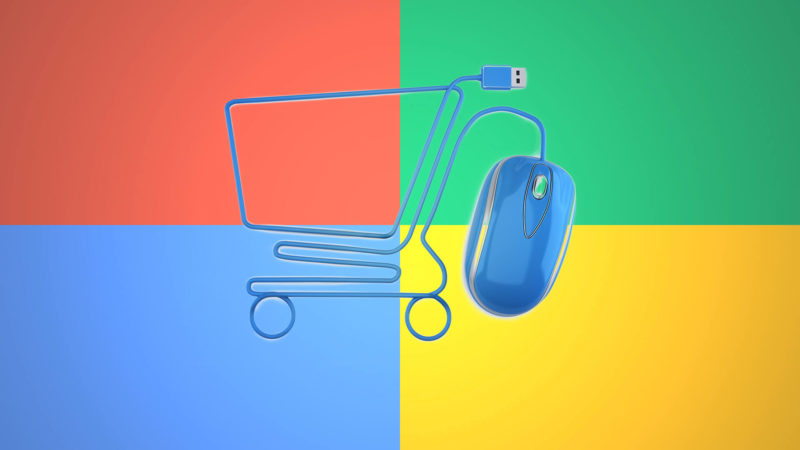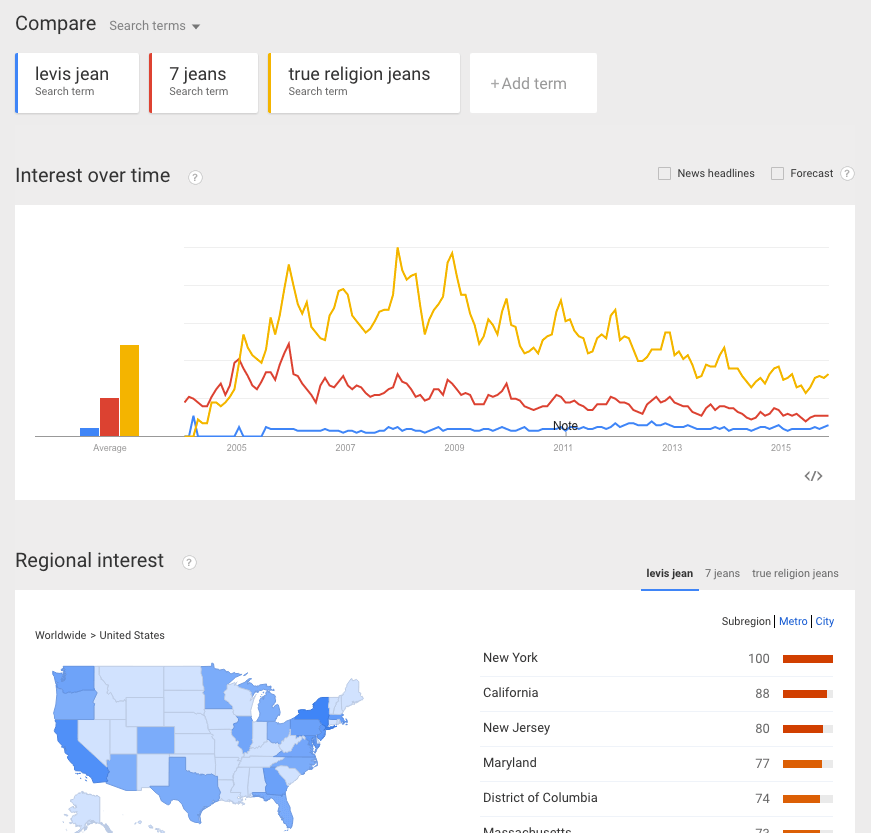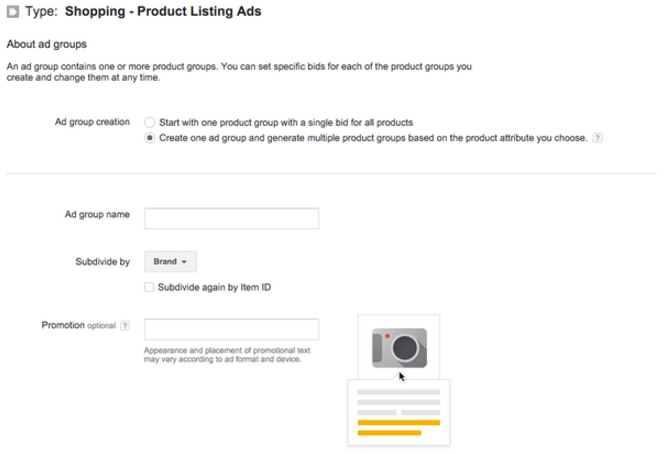
The AdWords team behind shopping ads has been very busy improving their offering, with at least 11 major new capabilities launched in the past six months.
Even if you’re using AdWords regularly, it’s easy to have missed some of these new capabilities that may be buried deep in the UI. To make sure you’re not missing any opportunities, here’s a roundup of what’s new in AdWords Shopping ads, along with my thoughts on how to use all these features to drive more sales and profits for your ecommerce business.
The new features fall into a few different buckets that I’ll cover here one by one:
- Finding what to sell
- Getting it added to your merchant feed
- Selling more
- Selling more profitably
I’ll wrap it up with a few extra tips based on my experiences with shopping ads.
Find Products You Should Sell
1. Shopping Insights
Google Trends has long been an amazing tool to help retailers figure out what products they should stock, and now Google has launched a variation of this tool that is geared specifically towards retailers: the Shopping Insights tool. The tool covers the 5,000 most popular products on Google Shopping.
Because the dataset is limited, Google Trends may still be the best way to gauge the interest in the products you carry. One classic example I’ve shared at many of my AdWords lectures is how to use Trends to see which brand of jeans may be most popular in various parts of the country.

The new Google Shopping Insights tool shows the most popular product searched in different regions and on different devices. Currently the data is limited to 5,000 products. Screenshot from google.com taken November 2015.

Google Trends lets you look beyond the 5,000 most popular products. In this example, we can look at any brand of jeans, even if it’s not in the top 5,000 of all products searched on Google. Screenshot from Google.com taken November 2015.
2. Assortment Report
The Shopping Assortment Report found in the Google Merchant Center shows the most popular products in categories where you also sell products. The idea is to tell you if there are popular products in those categories that you don’t offer and that might provide an opportunity to drive a massive amount of new sales.
Because these products are best-sellers, and there will be a lot of competition from other retailers, you shouldn’t expect these to contribute a lot of profit, but they could certainly drive a big increase in revenues when added to your product mix.
The report only includes products for which you have received no impressions for the past 14 days. This means you may actually have the product in your feed, but your bids and relevance are too low to get any traction.
To make sure you’re not missing any simple opportunities like this, cross reference your list of GTINs with those in the Assortment Report to find popular products that you sell but that aren’t getting any share of the available impressions.

This Assortment report shows that eBay usually has a higher prices for the most popular products in Apparel & Accessories. Screenshot from Google.com taken November 2015.
Because the Shopping Assortment Report shows reference prices from five sites for each product, it can be used to understand the pricing strategies of your competitors. Who is always offering the product for a penny less than the typical price? And which sites always have a higher price yet are still successful?
For example, eBay often has higher prices. This suggests that perhaps consumers mistakenly believe an auction always leads to a better price, so sellers on eBay can get away with charging more for the same products.
Simplify Creating Merchant Feeds
3. Google Merchant Center Add-On For Sheets
For small sites that don’t offer a lot of products, the easiest way to create a feed for the Google Merchant Center is through Google Sheets. Now, Sheets even offers a free add-on that helps with validating the data and submitting it to the Merchant Center.

The Google Merchant Center add-on for Google Sheets simplifies the creation and maintenance of a product feed that is compatible with Merchant Center, a prerequisite for running shopping ads on Google. Screenshot from Google.com taken November 2015.
Over the past year, Google Sheets has gotten powerful enough that I often prefer it over Excel, especially for working with AdWords data, which I can easily import into Sheets using AdWords Scripts. (There are many great examples of AdWords Scripts to start pulling data into Google Sheets on this site, as well as on Google’s Developer Site for Scripts.)
4. Online Product Inventory Update Feed
Larger advertisers who want to send continuous updates about prices and inventory can now use the online product inventory update feed. It updates faster than the full feed and won’t cause issues with the full product feed’s approval status if there are transient errors.
Showing the correct price for a product is critical to maintaining a great conversion rate, so this is a must-have for merchants who change prices more often than they typically update their main product feed.
5. Automated Product Group Creation
Google has made it easier to structure product groups by letting advertisers who are building new ad groups pick an attribute in their feed by which to split products into groups. This feature also lets advertisers put a single product into each resulting product group.
Here’s a use case where that can be useful: when you have 100 groups after splitting products by the different brands you sell, you’d have had to manually go and subdivide each of these 100 groups by item ID, a process that can be very time-consuming. Now, Google can do this two-level split automatically.

Automatically build product groups for new shopping ad groups. Screenshot from Google.com taken November 2015.
Sell More
6. Find More Clicks With The Click Share Column
Enable the new click share column to get insights beyond what you already get from impression share. Unlike impression share, which tells you how many times your shopping ad showed divided by how many times a user within your targeting searched for your product, click share shows how many clicks you got divided by how many times your ad was competitive enough to potentially get a click.
If your impression share is good, but your click share is low, it may be because your shopping ad is not appealing, so fix the elements that influence CTR (i.e., the things that show up in the ad like price, image and headline). On the other hand, if you are losing impression share, increase your rank by increasing your bid or improving your quality (CTR).
Remember, Google makes money through a combination of CPC and CTR (because Ad Rank, also known as CPM = CTR x CPC x 1,000), so your relevance is just as important as your bid.
7. Utilize YouTube Shopping Ads
When Shopping ads launched last year, they could only show on Google SERPs; now, however, they can be syndicated to search partners like YouTube, Walmart.com and others, so these provide a big opportunity for driving more volume.
Google is making two flavors of shopping ads available on YouTube:
TrueView For Shopping. TrueView for Shopping will automatically create cards from the data in your Merchant Center to show in your own in-stream TrueView ads, thus making it easier for users who see your video ad to purchase it from your site. To enable this feature, you will need to ask a Google rep.
Shopping Ads On YouTube. Shopping ads on YouTube is already available to all advertisers because it’s just a part of the Google Search Network. When you opt in to show your ads on search partners, someone who is watching a video review of a product you sell can see a card with your product overlaid in that video.

Shopping Ads can now appear as cards on YouTube by opting into the search partners option of a shopping campaign in AdWords. Screenshot taken on Google.com in November 2015.
As you run your ads on search partners, be sure to segment your AdWords reports by “Network (with search partners)” to make sure that your results on these partner sites are good enough to justify the money you’re spending there. Results that I’ve seen have been good, but it’s always a good idea to check your own data as more partner sites start to drive clicks on shopping ads.
Sell More Profitably
8. Flexible Bid Strategies For Shopping Ads
Last year, I recommended structuring shopping campaigns into ad groups so that you could take advantage of ad group-level features like mobile bid adjustments and negative keywords. Now, add flexible bid strategies to that list of features available for well-structured shopping campaigns.
The best bid strategy for e-commerce is almost certainly to target the ROAS that corresponds to your profitability goals. You can use this strategy so long as you’re adding conversion value data into AdWords, either with the AdWords conversion tracking code or with an import of Google Analytics’ e-commerce data.
The formula to calculate your target ROAS is as follows: to break even, you need an ROAS target of 1 divided by your margin. If you want to keep some profits, you subtract the amount of profit you want from 1 and then divide that by the margin: (1 – percentage of profit to keep)/margin.
Google recommends a bid strategy of “maximize clicks” if you’re promoting a sale and want to drive foot traffic for a local inventory ads campaign. Other flexible bid strategies make less sense for shopping ads, in my opinion.
9. Remarketing Lists For Shopping Ads
You can now add a remarketing audience to your shopping ad groups or campaigns. Like with RLSAs, they can be used to modify bids or to target only those people who are on a remarketing list.
Combine this with the very powerful new Customer Match feature where you can build an audience list by importing the email addresses of your current customers. You can even segment them based on how much they spent, how recently they purchased, or what types of products they bought.
You can then, for example, increase bids for customers who tend to place high-value orders and decrease bids for customers who buy very little and where there may be little profit left after you pay for your free shipping promotions for the holidays. (You are offering free shipping, right? Eighty-eight percent of consumers say free shipping makes them more likely to buy.)
If you previously installed the code for Dynamic Remarketing (where Google automatically inserts products users looked at into display ads), AdWords will already have created some other useful audience lists like shopping cart abandoners. These may be an excellent audience to pursue with a more aggressive promotional ad or with a more aggressive bid strategy.
10. Automated Extensions For Shopping Ads
As I said in my column about Shopping ads last year, there was no point adding promotional text to ad groups because virtually no user would ever see it, and Google has now retired this feature. Now, Google will automatically try to make your ad more clickable by including details about your promotions.
To get this to work, be sure you have a promotions feed added in your Merchant Center, and keep your prices up-to-date so that Google can indicate when there is a price drop and a great opportunity for prospective buyers to put down their plastic.

Now that the promotional text for shopping ads has been retired, Google may automatically enhance shopping ads with automated ad extensions like these.
11. Bid Simulator
Use data from the Bid Simulator for shopping ads to estimate how many more clicks you could have gotten with different increases in your bids. This type of data lets you calculate incremental costs like “incremental cost per click” and “incremental cost per conversion,” which are critical to help you bid the right amount for your goal, whether that’s to maximize profit or revenue.
Tips And Tricks
As you can see, AdWords has made huge strides in making shopping ads more powerful and easier to manage, but like most power users, we’ve found a couple of additional scenarios that could be easier to handle, so here are a few final tips and tricks.
Keep Product Groups Synced With Your Merchant Feed
Even after you’ve taken the time to build a well-structured set of ad groups with well-divided product groups, your AdWords structure might get out of sync with the data in your Merchant Feed.
To make sure you’re never losing potential sales, I recommend always having a low-priority catch-all shopping campaign that targets everything in your feed. That way, you’ll always have a chance to show an ad for a product you sell. I also recommend you avoid getting too many clicks coming from these types of catch-all campaigns, or product groups of “everything else” because that’s akin to buying only broad match keywords for search ads: great for getting lots of traffic but lousy for giving you control over your ROI.
To balance the need to never miss a sale while keeping product groups neat, you have to periodically check that there aren’t any new items in the feed with attributes that require you to update your structure. Here’s a simple example. If you divided products into groups based on brands X and Y, and then your feed gets updated with a new product from brand Z, that brand would fall under “everything else” until you add brand Z as a product group.
You can do this manually by editing all of your current product groups, but that’s clunky, so at Optmyzr we built a Shopping Refresher tool that checks whether your AdWords structure matches what’s in your feed and automatically adds or removes product groups based on what changed.
Roll Up Data To Make Better Decisions
A common issue in AdWords has to do with data density for making optimizations like bid adjustments. A well-structured account with lots of tightly themed ad groups may get great Quality Scores, but it may leave you with too little data to act on when it comes to changing bids. Aggregating the data based on commonalities between elements helps increase data density.
Luckily, this is where a good structure helps: in product groups, you can roll up to a higher level of your product group splits, and in ad groups, you can roll up data to the campaign level. For example, if you’ve split all your products into groups of single item IDs, use a dimensions report to get aggregate stats for attributes like brand or product category where you have at least 15 conversions, and then use this larger set of data to help guide bids for those product groups that don’t have 15 conversions on their own.
Set Hourly Bid Modifiers For Shopping
My fellow columnist Daniel Gilbert shared a script to set hourly dayparting bid adjustments. We took inspiration from his idea and rewrote the script for our users. Based on feedback from one of our users, we decided to extend our script’s capability to also let you do hourly dayparting for shopping campaigns.
We’ve published a free single account version of the code to do hourly dayparts for shopping ads here, but you could also take Daniel’s code and replace the string var campaignIterator = AdWordsApp.campaigns() with var campaignIterator = AdWordsApp.shoppingCampaigns().
Isn’t it great how, with AdWords Scripts, you can take an existing script and (in this case) make it do something more by literally adding eight characters to it?
Conclusion
With so much new in shopping ads, now’s a great time to take another look to make sure you’re taking advantage of these 11 new capabilities AdWords offers.
The post AdWords Shopping Ads Enhancements: A Roundup appeared first on Search Engine Land.